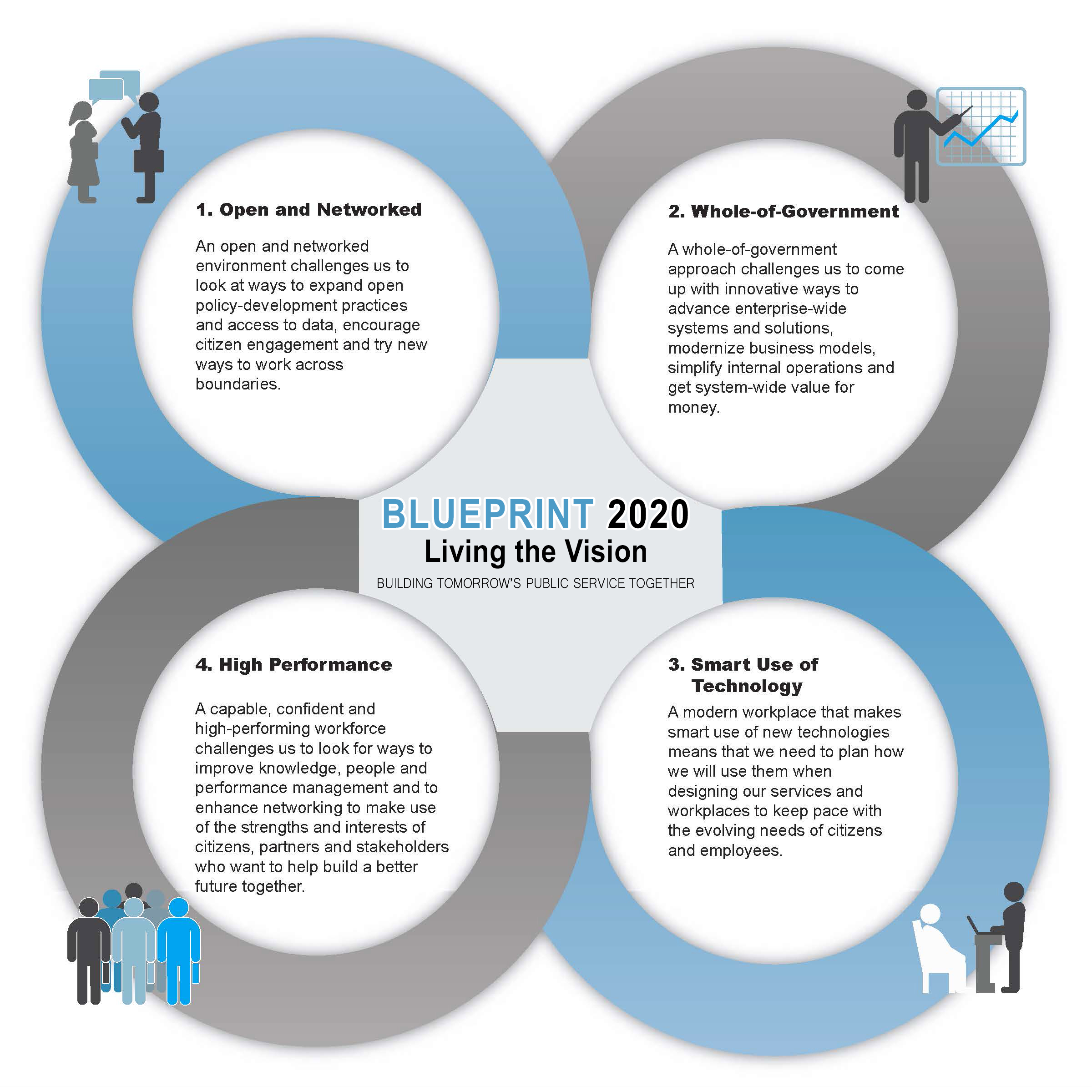Section II: Operating context—Conditions affecting our work: 2017 to 2018 Departmental Plan
Document navigation for "2017 to 2018 Departmental Plan"
Our operating context
As a central service provider, Public Services and Procurement Canada (PSPC) plays a critical role to enable federal departments to deliver on the government's core priorities: open and transparent government, social inclusion and diversity, inclusive and sustainable economic growth, and a safer and stronger Canada at home and in the world.

Text version
This graphic represents the four guiding principles that will help achieve the vision of "a world-class federal public service equipped to serve Canada and Canadians now and into the future."
Blueprint 2020: Living the vision—Building tomorrow's public service together
These four guiding principles are presented in this graphic in the following order:
- open and networked: an open and networked environment challenges us to look at ways to expand open policy-development practices and access to data, encourage citizen engagement and try new ways to work across boundaries
- whole-of-government: a whole-of-government approach challenges us to come up with innovative ways to advance enterprise-wide systems and solutions, modernize business models, simplify internal operations and get system-wide value for money
- smart use of technology: a modern workplace that makes smart use of new technologies means that we need to plan how we will use them when designing our services and workplaces to keep pace with the evolving needs of citizens and employees
- high performance: a capable, confident and high-performing workforce challenges us to look for ways to improve knowledge, people and performance management and to enhance networking to make use of the strengths and interests of citizens, partners and stakeholders who want to help build a better future together
We must support the delivery of high quality programs and services, even in the face of increasingly rapid technological change. Our federal department clients also seek to drive down costs to maximize resources available to deliver goods and services to Canadians. This imperative demands that PSPC constantly measures and evaluates its policies' and programs' performance, and uses the resulting information to increase efficiencies. In responding to our clients' needs, PSPC is committed to continuous improvement of our services to remain responsive in an evolving and dynamic context. In addition, PSPC is focused on continued progress toward a high-performing public service that embraces innovation, transformation and renewal.
In the context of service excellence, there must be a sustained commitment to explore innovative solutions, including enterprise-wide end-to-end solutions. The trend to large transformation initiatives offering integrated solutions means focusing on results and benefits for Canadians. It also means ensuring clear accountabilities, developing new skills, ensuring experienced teams are in place, as well as retaining a flexible approach to allow for course correction, if needed. PSPC must harness the lessons learned from current programs, including Phoenix pay administration modernization, to ensure that new approaches are well supported by effective policies, training and technical expertise to succeed. With 28% of the PSPC workforce eligible for retirement in the next five years, the effective transfer of knowledge to new employees will be critical.
As the government's largest purchaser of goods and services, PSPC's approach to procurement must foster innovation. The Build in Canada Innovation Program buys late-stage research and development products and services developed by Canadian companies for testing and evaluation by federal departments and agencies. Participating companies have reported achieving a more than 80% commercialization rate for their innovations through the program, with one third of these innovations purchased by departments through regular procurement channels. PSPC must build upon this successful program, collaborating with clients and stakeholders, to further drive innovation, accelerate research and development and commercialization, and grow Canadian firms.
The imperative to reduce the federal government's environmental footprint requires a fundamental re-think in the way PSPC does business, the way we manage federal buildings, what we buy, and how we manage acquisitions throughout their lifecycle to demonstrate leadership in meeting the government's environmental focus.
In its stewardship role, PSPC is responsible for the planning, rehabilitation, operation and maintenance of buildings and grounds in the parliamentary precinct. When undertaking the long-term restoration of the parliament buildings, PSPC manages standard renovation challenges, including cost and schedule. It also ensures that ongoing work minimizes the short-term impact for Parliamentarians and visitors to the National Capital Region, while realizing the long-term goal of delivering a parliamentary precinct that is part of Canada's identity.
PSPC must meet clients' expectations, while balancing our enduring commitment to deliver improved programs and services with integrity. Fair, open and transparent procurement processes, for example, deliver products and services in a manner consistent with the highest standards. This means that clients, businesses and Canadians can continue to have faith in the results. These considerations inform and guide our efforts to streamline procurement processes.
PSPC will continue to collaborate with federal partners to align our activities with government priorities to deliver clear results. This means internal changes, like adapting governance structures and procedures, must be adopted to streamline processes and deliver the highest quality programs and services to clients. Given the pace and scope of change we are managing, the department is increasing its efforts with respect to change management support for employees.Document navigation for "2017 to 2018 Departmental Plan"
- Date modified: